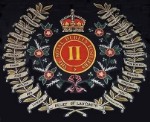Henry Nicholas Blackwood-Price
Henry Blackwood-Price was James Joyce's first friend in Trieste and that older man and his wife became close to James' brother Stanislaus Joyce. Stanislaus, a bachelor, was a frequent, welcome guest at the childless Blackwood-Price household.
Biography
Henry Nicholas Blackwood-Price was born on March 28, 1849 in Newtownards, County Down, Ireland. His father, Townley Blackwood-Price, was an archdeacon of the Church of Ireland and a graduate of Trinity College. His mother, Anne Henrietta Ward, was of the Anglo-Irish aristocracy. The Blackwoods, Prices, and Wards were notable landowners in County Down, Ulster.
Anne died at age 27 when Henry was three years old; she was Townley's second wife. The first wife also died young; age 28 in 1842. Henry had two older sisters: Harriet Anne Catherine and Maria Catherine. Harriet, born in 1845, became a clergyman's wife. Maria, born in 1847, never married and in the census gave her occupation as "lady artist." She had two works on display at the 1907 Irish International Exhibition, Dublin and apparently received local commissions.
A 1917 copy of a portrait by the 18th-Century English painter, George Romney. The subject is Arabella Crosbie, wife of Edward Ward, 3rd Viscount Bangor. He was a grand-uncle of Henry, Maria, and Harriet. The work is owned by the National Trust and hangs in Castle Bangor. Romney's work is in the National Gallery, Washington, DC. The above link is to a page on the website of the National Trust Collections which will open in a new browser window. The page will be slow to load. Note the digital image is property of the National Trust.
The Rev. Townley Blackwood-Price married a third time in 1855. Henry's step-mother was Sarah Olivia Lyle of County Derry, sister of Lady Dunleath (Frances Lyle, wife of Baron Dunleath). Sarah gave birth to two boys, Townley George in 1861, and Edward William in 1864. Sarah likely brought a good deal of money into the Blackwood-Price family. Both her sons attended Marlborough College, the renowned English public school, and Townley, Jr. Cambridge University where he obtained an M.A. In 1901, Townley, his wife, Maria, and Edward resided together on the outskirts of Downpatrick along with four servants. The next year, on February 4, the 88-year old Townley Blackwood-Price died. Two months later, Henry visited his family in County Down. Henry's stepmother died June 26, 1910. Henry and his sisters attended the July 7 funeral, as did his step-brother Townley, Jr.
Henry Blackwood-Price was employed by Eastern Telegraph Company for 37 years; the last 30 of which in Trieste. Prior to his career as a telegraphic engineer, he worked for a land agency in Ireland. In Trieste, sometime between 1901 and 1905, he married Anna Kaiser from Gloggnitz, Austria. She was born on May 7, 1858 and was Catholic. The marriage took place in the Trieste registry office. Anna never met his family, probably because of her religion. In 1905, Blackwood-Price befriended the much younger James and Stanislaus Joyce. He retired in 1911 and with his wife, moved to Mitterdorf, Austria, a village near Gloggnitz. Henry Blackwood-Price died there of heart failure on December 21, 1921. He was survived ten years by his wife who died on October 3, 1931. The couple was childless.
Henry's half-brother Townley, like their father, was an Anglican clergyman. Townley, Jr. who married in 1912, spent his entire clerical career in England and died at Exeter in 1939. In 1901, Henry's other half-brother, Edward, was an unemployed "gentleman."
Sources: L.A. Pooler, Down and its Parish Church (Downpatrick: 1907); Belfast and Ulster Directory, 1852, 1858-59, 1877; Marlborough College Register, 1843-1904 (Oxford: 1905); Alumni Catabrigienses, Volume 2 (Cambridge: Cambridge Univ. Press, 1940); Blackwood-Price Household Return, Census of England & Wales, 1901; Irish News and Belfast Morning News, April 17, 1902;Official Catalogue of the Irish International Exhibition (Dublin: Hely's, 1907); North Down Herald and County Down Independent, July 8, 1910; website of Museo Joyce, Trieste; Index to Marriages Abroad, UK National Archives RG 43/8; Catalog Entry, Styria State Archives, Herrschafts- und Familienarchive - Blackwood-Price Familie; The Times, January 9, 1922; National Archives of Ireland; General Register Office of England and Wales.
Newtownards, Ireland
"The town is beautifully situated not far from the northern extremity of Lough Strangford, well sheltered on the north and west by contiguous hills. It has been celebrated from a very early period for the number of religious foundations in its immediate neighbourhood. The town consists of one spacious square, with several wide streets leading from it, and others of inferior size. In the square, a handsome rectangular area, stands the town hall (1770), a large structure in Doric style; it contains assembly rooms, and beneath are the market offices, and the Young Men's Christian Association reading-rooms. Nearly in the centre stands the pedestal of an ancient cross, erected in 1636, ornamented with armorial sculptures, defaced by the rebels in 1653 and restored by the inhabitants in 1666. A charter was granted by James I, but has not exercised any municipal functions since 1821. The corporation returned two members to the Irish Parliament until the Union, when Newtownards was disfranchised. The ancient church, erected by Sir Hugh Montgomery, was converted into a court-house, but is now a ruin, and an excellent court-house and bridewell have been erected. The Protestant church (built 1817 and enlarged 1868) is a cruciform edifice with a lofty spire. The Catholic church (1875) is a handsome structure in Gothic style; the Presbyterians have six, and there are other places of worship for Unitarians, Wesleyan and New Connexion Methodists, and Covenanters. The principal benevolent institutions are a fever hospital and dispensary; the Model School is a large and elegant building in Elizabethan style. There are large markets or fairs on the second Saturday in every month, and annual fairs on January 23, May 14, and September 23. The embroidering and weaving of muslin, and the manufacture of gingham, handkerchiefs, and silk-weaving employ a large number of both sexes of the population. There are at Scrabo, between Newtownards and Moate, several quarries, producing stone little inferior to that of Portland. On Scrabo Hill (534 ft.), to the west of the town, stands a square tower, 130 ft. high, surmounted by a pinnacle, erected by the tenantry to a former Marquess of Londonderry. Mount Stewart, which has been greatly enlarged and embellished, is the seat of the Marquess of Londonderry."
n/ Cassell's Gazetteer of Great Britain and Ireland (London: Cassell, 1900).
The Illustrious Blackwood-Price Family
Blackwood-Price's ancestors, maternal and paternal, were of the landed, Anglo-Irish elite in Ulster, principally County Down. On his mother’s side, he was a descendant of an earl, a baron, and a baroness who held the title in her own right. His paternal uncle, James Charles Blackwood-Price, owned 6,807 acres in Co. Down with an assessed annual net income of £7,641. The family seat was the stately home of Saintfield House. His maternal aunt, Harriet, had married Robert Edward Ward of Bangor Castle. He owned 5,830 acres with an assessed annual income of £8,517. Blackwood-Price's distant maternal relations included the 5th Viscount Bangor (9,861 acres at £13,156) and the 6th Earl of Darnley (34,771 acres at £37,350). Note that Blackwood-Price’s yearly income never exceeded £276. Aristocratic families into which his ancestors married were those of the Earl of Camden, the Earl of Clanwilliam, and Baron Seymour-Conway.
n/ John Bateman, The Great Landowners of Great Britain and Ireland (London: Harrison, 1883).
The graphic is in a pdf (130kb) on this website which will open in a new browser window. Note that the tree is truncated; not all children of married couples are shown. Sources: Burke's Peerage, 1865; Walford's County Families, 1876; Burke's Gentry, 1882; Fox-Davies' Armorial Families, 1910; Marquis of Ruvigny and Raineval, The Plantagenet Roll (London: Melville, 1911); Burke's Irish Gentry, 1912; Burke's Peerage, 1915; various genealogical websites.
Note that John Blackwood, 2nd Baronet, was the Member of Ireland's Parliament who died while putting on his top-boots to go to Dublin and vote against Union. Sir John was not an ancestor of Blackwood-Price; Sir John's uncle, James Blackwood (d. 1755) was the ancestor.
Home of Blackwood-Price's maternal ancestors, the Viscounts Bangor. Click on the above link for the website of Castle Ward, a National Trust property. The homepage will apperar in a new browser window. Note that Game of Thrones, the HBO television series, was filmed in part at Castle Ward. Click here for a location photo from the National Trust which will open in a popup window.
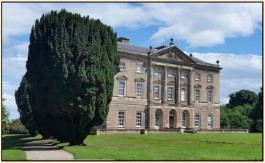
Photograph by "Pat D" on Tripadvisor, 2017.

Home of Blackwood-Price's paternal ancestors, the Prices of Saintfield. Click on the above link for the property's page by Courtenay Mercer on the website Public Historians.

Photograph by Timothy W. Ferris, c. 2014.

The Eastern Telegraph Company
Blackwood-Price began his career with Eastern Telegraph in June 1874 at the "advanced" age of 25 (most trainees were in their teens). Like all potential telegraph engineers, he began as an unpaid, apprentice telegrapher. He received his initial training at Eastern Telegraph's training college in Porthcurno, Cornwall. At the time, Porthcurno was no more than a hamlet and the nearest large town, Penzance, had a population of 10,414.
The 1871 Census shows 10 student-boarders at the ETC Porthcurno training facility, one a subject of the Grand Duchy of Oldenburg. Also resident were the facility's head, his wife, and three servants. Ten years later there were 27 student boarders. Reflecting the Company's increasingly imperial nature, 7 trainees were foreign-born British subjects (Philippines 1, Egypt 1, India 3, Canada 2). In addition to the head and his wife there were 5 resident support employees, including a nurse.
n/ Census Transcripts, Cornwall Online Census Project, sites.rootsweb.com/~kayhin/ukocp.html.
View of ETC College from Path to the Beach
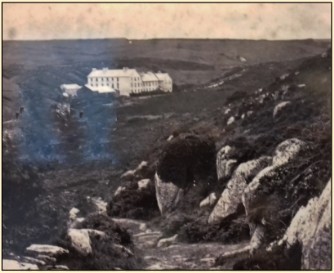
Some Staff Members and Trainees
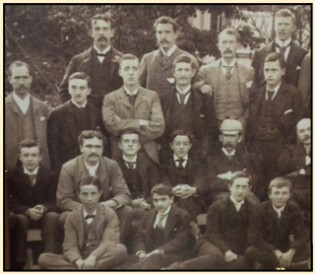
Porthcurno Telegraph Museum (Penzance), Cornwall
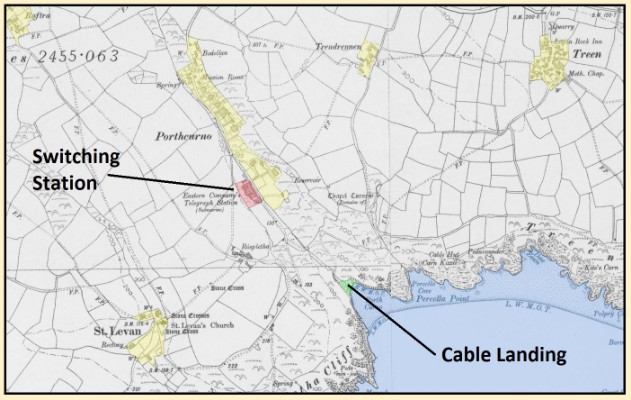
Ordnance Survey, 1888 - National Library of Scotland
Eastern Telegraph, together with its affiliates, was the world's largest telecommunications company, and like several other large British companies was an instrument of imperial power. Nearly all British military, naval, colonial, and diplomatic overseas telegrams were routed through Eastern's network. The Company recruited for its professional staff middle class boys and young men who lacked independent means and were in need of a livelihood. Eastern Telegraph engineers were the sons of colonial service officers, civil servants, clergymen, lawyers, physicians, and officers of the armed forces. Young Henry Nicholas was most certainly the British establishment type that Eastern Telegraph sought to fill its professional and management ranks.
In January 1875, after seven months of classroom and practical training, Blackwood-Price qualified as a telegrapher. His first posting was to Eastern Telegraph's relay station at Porthcurno, co-located with the training facility. This was the landing point for the submarine cables that connected England to Africa, Gibraltar, the Mediterranean, and on to India. His initial salary was £60 per year and in addition to his job duties, he received instruction in electricity and telegraphic engineering. It was from among the work-study, junior telegraphers that the Company selected its entry-level engineers.

Porthcurno Telegraph Museum (Penzance), Cornwall
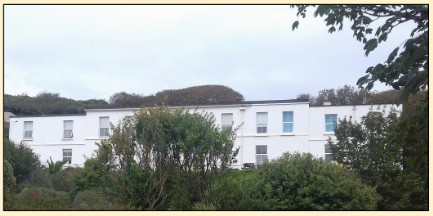
ETC Switching Building, Porthcurno. Now houses the Telegraph Museum.

Porthcurno Beach, 2019, landing point for numerous underseas cables.
In September 1875, Blackwood-Price qualified as a probationary engineer and the Company increased his salary to £72. He passed his probation within a year and his annual salary rose to £84. In October 1876, Eastern Telegraph transferred him to its Marseilles station and raised his annual remuneration to £96. Marseilles was the first city in which Blackwood-Price resided. The move to Marseilles was a major change in his life. He was accustomed to village life in Ulster and Cornwall and then found himself in the rough-and-tumble, cosmopolitan, French port city. While there, he applied for membership in the Society of Telegraph Engineers and in April 1877 was elected an "Associate" of that London-based, professional organization. In December, Blackwood-Price received his last pro forma promotion when Eastern Telegraph awarded him the rank of "Assistant Electrician" with an annual salary of £108. At the time he was 28 years old.

Membership Application Forms, Institution of Engineering & Technology Archives, DEP/09/01
In July 1878, Blackwood-Price went on special assignment in the Company's Levant Division. Over the next 40 months he was stationed in Salonika (Ottoman Empire), Syra (Syros, Greece), and Candia (Heraklion, Crete). During this period his annual salary was £156. Blackwood-Price's Levant tour ended in November 1881, when Eastern Telegraph assigned him to its soon to open Trieste station. The station connected a recently laid cable from Corfu, Greece to the state telegraph system of the Austro-Hungarian Empire. One year after his Trieste posting, Blackwood-Price received a merit promotion to the rank of "Electrician" with a raise in salary to £204. (Orange markers in the map below indicate employment postings.)
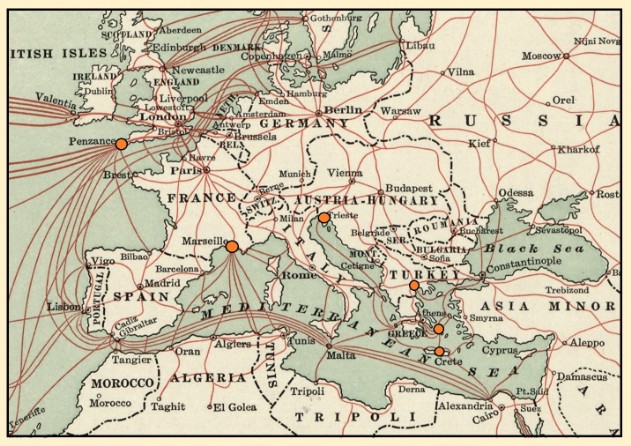
Telegraph Map, 1900 - Library of Congress
Eastern Telegraph's Corfu-Trieste cable landed in Continental Europe 7 kilometers north of Trieste at a small beach near the Hapsburg imperial residence of Miramar Castle. From there it ran overland to the Company's switching station in central Trieste at Via Carintia, 12. Twelve years later Eastern Telegraph would relocate its Trieste facility to the Pallazo delle Poste (photograph-modern and drawing-historic at commons.wikimedia.org that will open in a popup window), which was about 300 meters from Blackwood-Price's apartment at Via Fabio Servero, 1. In January 1889, Blackwood-Price was promoted to "Chief Engineer" at an annual salary of £240. At the time he was 40 years old and this would be his last promotion. Ten years later he was elected a full Member of the Institution of Electrical Engineers, after which he used the post-nominal MIEE on all correspondence. Blackwood-Price retired in August 1911, at age 62. Immediately prior to retirement his remuneration was £240 in salary plus a housing allowance of £36.
Sources: Staff Record No. 1, Cable & Wireless Archives, Porthcurno, DOC/ETC/5/25; Wendy Gagen, "Not Another Hero," in Men After War, edited by Stephen McVeigh and Nicola Cooper (New York: Routledge, 2013); Jill Hills, The Struggle for Control of Global Communications (Chicago: Univ. of Illinois Press, 2002); [Steve Bladon], Changing Places (Porthcurno: The Cable and Wireless Porthcurno and Collections Trust, 2016); Hydrographic Office, Admiralty, The Mediterranean Pilot, Vol. III (London: HMSO, 1908); various issues - Journal of the Institution of Electrical Engineers , the trade magazines The Electrician and the Telegraphic Journal & Electrical Review, the directories Electrical Trades Directory & Handbook and Berly's Universal Electrical Directory.
Trieste and James Joyce
Henry Blackwood-Price was one of Joyce's first friends in Trieste. The Blackwood-Price couple were childless and apparently, the older man took a fatherly interest in James and later his brother, Stanislaus. The Ulsterman often treated James and Nora to concerts and dinner, at both restaurants and his home, and frequently had the bachelor Stanislaus over in the evenings. Joyce, as he did with all his friends, borrowed money from Blackwood-Price. Stanislaus, in lieu of repayment by his deadbeat brother, gave English lessons to Blackwood-Price's wife, Anna. For Stanislaus, this was a trying experience as Anna was a slow learner (scholarly Stanislaus thought her stupid). Blackwood-Price had a piano at his apartment and when James, Nora, and Stanislaus visited, James would play it and all sang. Blackwood-Price, a unionist, attended Joyce's 1907 Irish nationalist lectures at the Salla Della Borsa, and found them praiseworthy.
Joyce gave his friend a copy of his first published book, the poetry collection Chamber Music, and asked him to review the Dubliners' manuscript, which Blackwood-Price did.
While living in Trieste, Blackwood-Price visited Ireland at least twice. In April 1902, he went to Co. Down to attend to matters of his father's testamentary estate; Rev. Townley Blackwood-Price died on February 4, 1902 at age 88. In July 1910, he attended the memorial service for his step-mother, Sarah Olivia Blackwood-Price, who died on June 26, 1910 at age 89.
n/ Correspondence of James Joyce (see below); Laura Pelaschiar, "Stanislaus Joyce’s 'Book of Days': The Triestine Diary," James Joyce Quarterly 36, no. 2 (Winter 1999): 61-71; unpublished diary of Stanislaus Joyce, Book of Days, Richard Ellmann Papers, University of Tulsa Library, 88.012.1.142; Erik Schneider, "Henry Blackwood-Price" on the website of Museo Joyce, Trieste; John McCourt, The Years of Bloom, James Joyce in Trieste (Madison: Univ. of Wisconsin Press, 2000), 175, 185-86, 213; Belfast News-Letter, February 5, 1902; Belfast Morning News, April 17, 1902; North Down Herald, July 8, 1910.
Click on the above link for a description of Joyce's correspondence with or about Blackwood-Price. The material is in a pdf on Major Tweedy's Neighborhood and will appear in a new browser window.
Retirement in Styria, Austria
Blackwood-Price retired from the Eastern Telegraph Company in August 1911. He and his wife left Trieste and moved to the Styrian village of Mitterdorf, located about 45 kilometers southwest of Gloggnitz, the hometown of his wife Anna. Note that in 1901, he had built a villa there on town lot 137. He named the house "Annenhof" which translates to "Anne's courtyard." In 1910, Mitterdorf had 1,659 inhabitants; Gloggnitz 6,428. After having lived over 30 years in an urban environment, Blackwood-Price returned to village life. The couple were moved in by the end of the month as he wrote to Joyce from Mitterdorf on August 25.
n/ Catalog Entry, Styria State Archives, Herrschafts- und Familienarchive - Blackwood-Price Familie; Letter from Henry Blackwood-Price to James Joyce, August 25, 1911, Mitterdorf auf Murzthal. Joyce Collection, Cornell University (Scholes No. 1086); Letter to William Field, Freeman's Journal, August 19, 1912.
Styria in the Austro-Hungarian Empire

Mitterdorf
In 1910, Mitterdorf (now known as Mitterdorf im Murzthal), had 1,659 inhabitants of which 1,600 the Empire classified as ethnic Germans. Religious professions were Catholic 1,608, Protestant 27, Jewish 24. The 1883 Baedeker for the Eastern Alps notes that the village has one inn, of poor quality, but that the Schests, father and son, are good guides. The book also states that located there is a "large gun-manufactory." The 1887 Baedeker for Southern Germany and Austria does not mention the inn or the Schests, but states that the village has "a manufactory of small arms."
Mitterdorf is in a river valley through which ran the main railway line that linked Vienna to Venice via Bruck and Klagenfurt; Vienna to Trieste via Bruck, Graz, and Ljubijana. Travel time between Mitterdorf and Vienna was about 3 hours; Mitterdorf and Trieste 10 hours.
n/ S. Steinbach, Alternative Transport, alternativetransport.wordpress.com.
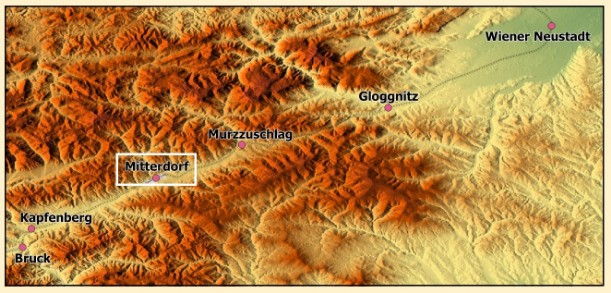
During the time Blackwood-Price resided in Mitterdorf, economic activity in the valley included farming, grazing, small-scale coal and metal mining, and some manufacturing and metal fabricating.
The nearest city to Mitterdorf is Wiener Neustadt (1910 population of 32,874), halfway to Vienna.
Village of Mitterdorf
Hapsburg Empire (1869-1887), Third Military Survey
Place cursor on image then use the scrollwheel to zoom in and out. Click-and-drag to move the image. From the website of Arcanum Maps, maps.arcanum.com/en/.
Postcard, c. 1909.
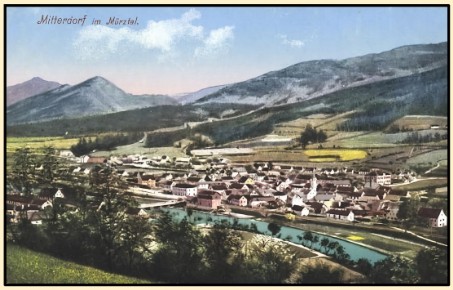
For a 2010 photograph of the village click here. The image will appear from the Austrian Forum website (www.austria-forum.org) in a popup window.
Foot-and-Mouth Disease
In Summer 1912, foot-and-mouth disease erupted on a cattle farm north of Dublin and spread to Great Britain through cattle shipments. In response, the British Board of Agriculture banned importation of Irish livestock and froze movement of animals within Great Britain. Agricultural authorities in both Ireland and England ordered the destruction of stricken cattle and livestock likely to become infected. This was disastrous for Ireland's agriculture-based economy as animal grazing, not crop production, was the island's principal agricultural activity. In 1910, excluding grazed mountain land, 67% of Ireland's agricultural acreage was utilized in grazing, 17% hay production, and 16% crop production. (Note that potatoes were grown on only 4% of Irish farm land.) Irish livestock accounted for 40% of all cattle in the UK and about 850,000 head were exported to Great Britain annually. Irish agriculture employed directly about 1.0 million people and animals accounted for three-fourths of agricultural income.
n/ Department of Agriculture and Technical Instruction for Ireland, Agricultural Statistics of Ireland, 1910, 1911, [Cd. 5964]; Cormac O Grada, Irish Agriculture after the Land War, Working Paper 04/06 (2004), Centre for Economic Research, University College Dublin.
Joyce was in Dublin from July 12 through September 11 to expedite publication of his book of short stories, Dubliners. Blackwood-Price, claiming that Austrian veterinarians could cure foot-and-mouth disease, wrote to Joyce to bring that finding to the attention of influential, Irish personages. Blackwood-Price had previously written about the matter to William Field, President of the Irish Cattle Traders' and Stockowners' Association and Member of Parliament. The Ulsterman persuaded Joyce to coax Field into publicizing the Styrian cure. Field in turn, convinced the editorial staff of the Freeman's Journal and Evening Telegraph to publish what was taking place in Styria. Blackwood-Price's report appeared in both newspapers on August 19. A Freeman's Journal sub-editorial of September 6 further promoted the apparent cure used in Styria.
"Mr. Blackwood Price, an Irishman who has resided for some thirty years in Austria, has written more than once against the wholesale slaughter of Irish cattle, and has furnished the Ministry with the names and addresses of several Austrian veterinary surgeons who are quite willing to come over to Ireland, without fee or salary, in order to demonstrate the efficacy of the treatment."
A week later, the newspaper ran another of Blackwood-Price's letters on foot-and-mouth disease. Joyce's friend in Austria later contributed an article on the Pyoktanin treatment used in Styria to the weekly, republican newspaper, Sinn Fein.
n/ Terence Matthews, "An Emendation to the Joycean Canon: The Last Hurrah for 'Politics and Cattle Disease'," James Joyce Quarterly 44, no.3 (Spring 2007): 441-53; The Freeman's Journal, September 6 and 14, 1912.
A brief article in the Farmer's Advocate and Home Journal of August 28, 1912. That weekly publication, founded 1866, is based in Winnipeg, Manitoba. Manitoba is one of Canada's three prairie provinces which are noted for grain production and grazing. The article is in a pdf on Major Tweedy's Neighborhood and will open in a new browser window.
Department of Agriculture and Technical Instruction for Ireland, Report on Foot-and-Mouth Disease in Ireland for the year 1912, 1913, [Cd. 7103]. From the Internet Archive. The report will open in a new browser window.
The report of a "Styrian cure" was published on August 19, 1912. Field had convinced the editors of the Freeman's Journal and Evening Telegraph to publish the letter he had received from Blackwood-Price. To read that letter as it appeared in the newspaper, click on the above link. The letter is in a pdf on Major Tweedy's Neighborhood and will open in a new browser window.
In the newspaper, Blackwood-Price's letter is prefaced as follows:
Dear Sir -
In view of the sporadic outbreaks of foot-and-mouth disease in England and Ireland and the enormous cost to the ratepayers which would result if the policy of slaughter is to be continued, the publication of the following letter from an Irishman in Styria may be useful. Apparently this disease is travelling westward, and as the slaughter of the animals has not up to the present been quite successful in staying its course a trial of the method suggested might be made.
I have no desire to interfere with professional practice or advice, but with the safeguards proposed of isolating the cattle and drawing a cordon round the infected areas the danger of contagion would be minimised. Therefore under existing circumstances, having asked a question in the House upon this subject, and as the writer has already communicated with the Board of Agriculture in England and the Department of Agriculture in Ireland it may be expedient to publish this proposal made in good faith to [me].
With best wishes - Truly yours,
WILLIAM FIELD
The article on the Styrian Foot-and-Mouth cure appeared in the November 2 and November 9, 1912 issues of Arthur Griffith's weekly, Sinn Fein. The article, by "An Exile of Erin" occupies 7.5 columns of newspaper space. Click on the above link to download that publication's November issues in a pdf. Blackwood-Price's article is titled "Fighting the Cattle Plague at Home and Abroad" and appears on pdf pages 4 and 10.
The file is on the website of the Center for Research Libraries, "an international consortium of university, college, and independent research libraries." For the Sinn Fein catalog page, click on the icon to the right and it will open in a new browser window.
Reportage of the epidemic in the Canadian Farmer's Advocate and Home Journal from July 23 through November 27. Five short articles in a pdf on Major Tweedy's Neighborhood that will open in a new browser window.
Selected Parliamentary Debates, Foot-and-Mouth Disease
Click on the link and a transcript of the Parliamentary proceeding will open in a popup window. The transcript is a page from Hansard's on the UK Parliament's website. Click on the icon for the Hansard home page which will open in a new window.
The First World War: Blackwood-Price, Enemy Alien
Like the Joyces in Trieste, at the outbreak of the First World War, Blackwood-Price and his wife, a British subject through marriage, were enemy aliens in their nation of residence: The Austro-Hungarian Empire. The situation for the Blackwood-Price family; however, was different from that of the Joyce family. Blackwood-Price lived in a remote village of little economic consequence, had an Austrian-born wife, and was not known to the authorities as having radical or anti-Hapsburg beliefs. The Joyce's lived in a strategic city (Trieste was the Empire's only mercantile port) and both James and his brother Stanislaus were considered security risks by the police. Furthermore, the Joyces had no ties to Austria, either by blood or marriage. The only factor in their favor was they were nominally Irish Catholics and presumably anti-British.
Restrictions on enemy alien movement in the Austro-Hungarian Empire began at the outbreak of war. By August 18, 1914 the police had arrested 95 enemy aliens, including 23 British subjects, who were interned at Schloss Karlstein, an uninhabited country estate. The aliens interned initially were suspected spies and other persons the police deemed a threat to the state. In 1914 there were 1,286 British subjects in Austria and its dependencies; 512 in Hungary.
Beginning in November 1914, the government broadened its internment policy and more and more enemy aliens were confined. In December 1915, Stanislaus Joyce was arrested in Trieste along with four other resident, British subjects. In January 1915, Joyce's brother was confined at Schloss Kirchberg an der Wild, and later in Schloss Grossau bei Raabs. Both internment facilities were about 100 kilometers northwest of Vienna and close to the German border. In June, James and his family received government permission to leave Austria for Switzerland. They left Trieste on June 27, 1915.* In 1916, the Austro-Hungarian government closed Schloss Grossau as a detention center and transferred Stanislaus to the notorious Katzenau Camp, a former army training facility on the south bank of the Danube, just west of Linz. Katzenau was almost exclusively a detention center for Italian nationals and Austrian subjects of Italian ancestry. Conditions there for the 5,000 internees were egregious. Poor sanitation, inadequate diet, over-crowding, and insufficient protection from the cold were the chief shortcomings. In 1917, James Joyce wrote to the British Foreign Office requesting financial assistance for Stanislaus (internees could purchase supplemental food and clothing).
On May 23, 1915 Italy declared war on Austria-Hungary. At about that time, the Hapsburg Empire had in place procedures to control resident British subjects. Enemy aliens without independent means who were not engaged in war work were interned in camps. Well-to-do aliens in Vienna and strategic locations were exiled to remote, rural regions. There they were "confined" to the vicinity of their residence. British subjects of independent means residing in non-strategic areas had their movements restricted. The Blackwood-Prices were in this last category. In May 1915, Austrian camps held only 75 British subjects; in September, Hungarian camps held 26. Note that only 5.6% of British enemy aliens were interned.
For confined British subjects, the primary hardship was obtainment of food and other consumer goods. While money came from abroad freely through neutral Spain and Switzerland, ration coupons were more limited for enemy aliens than Austrian subjects. Furthermore, many shopkeepers would not sell to foreigners or charged them exorbitant prices. Joyce's friend from Ulster probably benefited greatly from his Austrian wife and her relatives located a short train ride away in Gloggnitz.
* Before the Joyces received permission to leave Austria, James sent a postcard to Stanislaus, still in Schloss Kirchberg. In the postcard, written in German, James informs his brother "Die erste Episode meines neues Roman "Ulysses" ist geschrieben." [The first episode of my new novel Ulysses is written.] The postcard is dated "16 June 1915." The complete novel would be first published on February 2, 1922, Joyce's 40th birthday.
Sources: Frank K. Stanzel, "Austria's Surveillance of Joyce in Pola, Trieste, and Zurich," James Joyce Quarterly 38, no. 3/4 (Spring-Summer 2001): 361-71; Erik Schneider, "Chronology," Website of Museo Joyce (Trieste); Richard Ellman, ed., Selected Letters of James Joyce (New York: Viking, 1975), 209; International Red Cross, Rapports de Ferriere and Schulthess-Schindler sur leurs visites a quelques camps de prisonnaiers den Autriche-Hongrie, (Geneva: Georg, 1915); Matthew Stibbe, "The Internment of Polical Suspects in Austria-Hungary during the First World War" in Gender and Modernity in Central Europe, edited by Agatha Schwartz (Ottawa: Univ. of Ottawa Press, 2010); Catalogue of The National Archives, UK, Entry for FO 383/251; Matthew Stibbe, "Enemy Aliens, Deportees, Refugees: Internment Practices in the Habsburg Empire, 1914-1918," Journal of Modern European History 12, no. 4 (2014): 479-92.
